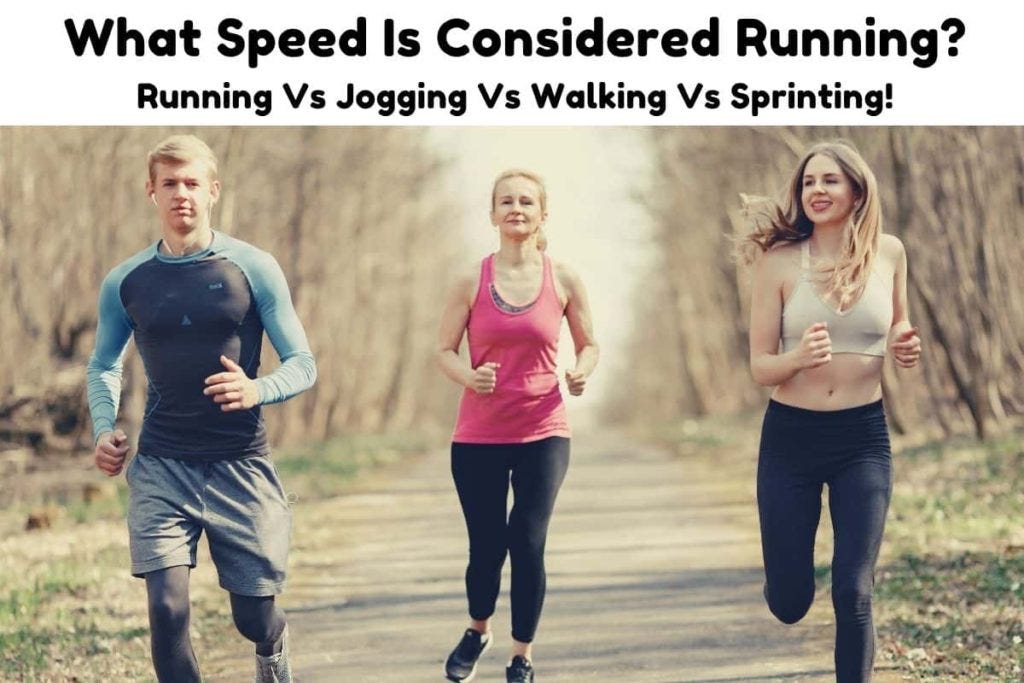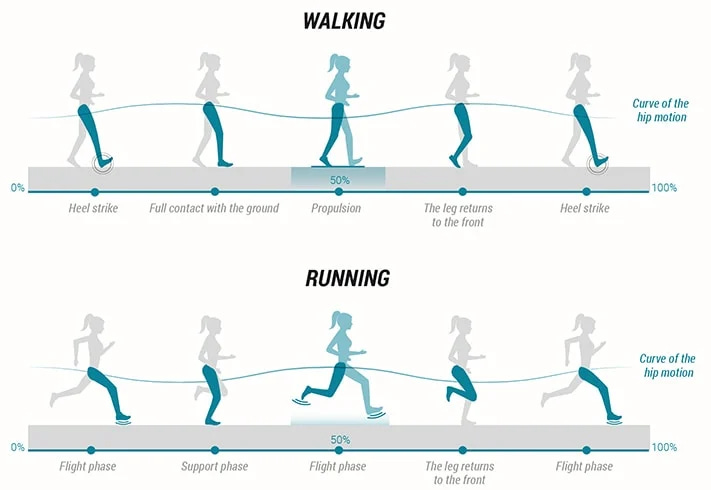Differences between running, jogging, and sprinting, from a biomechanical perspective.
with cues and muscle groups explained!
Walking, jogging, running, and sprinting are all different forms of movement that vary not only in speed but also in form, level of effort, and oxygenation.
Walking is fundamentally different from jogging, running, and sprinting in that when a person is walking, they always have at least one foot touching the ground. On the other hand, when a person is jogging, running, or sprinting, there are moments between steps where both feet are off the ground, known as flight time. Although jogging may seem slower than walking for some individuals, it still includes flight time.
Jogging and sprinting are specific types of running, differentiated primarily by the level of effort exerted. Running encompasses any speed that includes flight time, whereas jogging occurs when a person runs as slowly as possible and sprinting takes place when a person runs as fast as they can. The pace of walking, jogging, running, or sprinting varies among individuals and can change depending on circumstances, fatigue, and terrain. For example, sprinting speeds may slow down when running uphill due to the additional energy required to overcome the incline, and elite racewalkers provide an interesting example of how walking can be faster than sprinting for some individuals. Racewalkers can walk at speeds exceeding 10 mph (16 km/h) by always ensuring that at least one foot is touching the ground, thereby eliminating any flight time.
Another significant distinction is the impact on oxygenation. Walking, jogging, and running typically allow the body to maintain a steady supply of oxygen, enabling the exercises to be sustained over longer durations. These are considered aerobic exercises. In contrast, sprinting is an anaerobic exercise, demanding such a high level of effort that the body's oxygen supply is depleted quickly, requiring a brief cessation of sprinting to restore oxygen levels. It’s important to note that the speeds at which individuals walk, jog, run, or sprint can vary widely. An elite marathon runner, for example, can sustain speeds exceeding 12 mph (19.3 km/h) for hours, showcasing their exceptional aerobic capacity. Conversely, many individuals may struggle to sprint at such speeds for even a few seconds.
While speed is a crucial factor in distinguishing between these forms of movement, the underlying differences in form, effort, and oxygenation are equally essential considerations. These differences contribute to the diverse ways in which individuals engage in and experience walking, jogging, running, and sprinting, reflecting the multifaceted nature of human movement and physical capability
.
Sprinting is associated with power and speed, focusing on explosiveness and top speed. Sprinters have a larger muscle mass and exhibit a higher range of motion at both the hip and knee. Their form involves elevated thigh amplitude, a significantly lower degree of knee extension at toe-off, and a more forward position of the recovery knee at touchdown, all contributing to their explosive movement and power. Sprinting is characterized by shorter foot-to-ground contact times and faster leg recovery.
On the other hand, distance running is all about efficiency and smoothness of movement. Distance runners exhibit fluid and economical form with an emphasis on minimizing energy expenditure. Their form involves little wasted motion, rear-foot landings to absorb impact, and is characterized by a higher degree of knee flexion for a quicker recovery of the leg. Distance running also involves longer foot-to-ground contact times and longer strides for maintaining a steady pace over long distances. When distance runners attempt to sprint, there is still a noticeable difference in technique compared to actual sprinters, as they maintain their distance form. This points to the intrinsic differences in form and technique between the two groups, which are present even when running at equal or maximal speeds.
These differences in technique and form show that proper training and technique are crucial for each type of running, and understanding these variations can be essential for improving athletic performance, especially near the finish line. Additionally, understanding the importance of analyzing the biomechanics and musculoskeletal dynamics involved in both sprinting and distance running, sheds light on the precise techniques and muscle movements that lead to improved performance in each type of running.
Energy Burned: Sprinting and distance running also differ in terms of energy expenditure. Sprinting is characterized by brief, high-intensity bursts of activity that heavily rely on anaerobic metabolism. This means that sprinting primarily uses stored adenosine triphosphate (ATP) and creatine phosphate for energy, allowing for rapid and powerful muscle contractions. In contrast, distance running predominantly utilizes aerobic metabolism, harnessing oxygen to break down carbohydrates and fats for sustained energy over extended periods.
Breathing and Oxygen Consumption: Sprinting and distance running also elicit differences in breathing patterns and oxygen consumption. Sprinting demands rapid and forceful movements, which requires an intense intake of oxygen to support anaerobic energy production. In contrast, distance running involves a more sustained and controlled breathing pattern, as athletes aim to optimize their oxygen consumption for endurance over long distances.
The biomechanical differences between sprinting and running
1. Stride Length and Frequency: In sprinting, athletes exhibit longer and more explosive strides, with a higher frequency of steps. Sprinters aim to cover a given distance in the shortest amount of time possible, necessitating powerful propulsion and rapid leg turnover. This is achieved through significant extension of the hip, knee, and ankle joints, generating forceful ground contact for each stride. In contrast, distance running emphasizes a more consistent and efficient stride length and frequency to maintain sustained movement over long distances while conserving energy.
2. Muscle Engagement: Sprinting places a premium on explosive muscle engagement, particularly in the glutes, hamstrings, quadriceps, and calf muscles. These muscles work in concert to produce rapid and forceful movements, generating high levels of power with each stride. In distance running, the focus is on endurance-based muscle engagement, with greater utilization of the hip flexors, quadriceps, and stabilizing muscles throughout the body to sustain a steady pace over extended periods.
3. Foot Strike Pattern: Sprinters often utilize a forefoot or midfoot strike pattern, emphasizing rapid turnover and propulsive forces that push the body forward. This foot strike pattern maximizes force production and minimizes ground contact time. On the other hand, distance runners tend to utilize a more varied foot strike pattern, often ranging from a midfoot to a heel strike, which helps with shock absorption and energy conservation over long distances.
4. Body Positioning: Sprinting involves a more pronounced forward lean at the start of a race, with the upper body inclined forward to facilitate explosive acceleration. This forward lean helps to drive the body's center of mass forward, enabling swift and powerful strides. In contrast, distance running typically involves a more upright posture to optimize energy efficiency and minimize excess strain on the body over prolonged periods.
5. Joint Range of Motion: Sprinters exhibit greater range of motion at the hip, knee, and ankle joints, allowing for more explosive and powerful movements. The hip, knee, and ankle joints work in unison to produce rapid and forceful leg movements that drive the body forward with maximum power. In distance running, the emphasis is on maintaining a consistent and efficient range of motion to sustain a steady and economical pace over long distances.
6. Lever Magnification: One key aspect to consider is the concept of lever magnification. In sprinting, the body's lever system works to maximize force production and acceleration. When a sprinter pushes off the ground, the lever system in the body magnifies the force generated by the muscles, leading to a rapid and powerful movement. This involves a coordinated effort from various muscle groups to create explosive force and propel the body forward effectively. These biomechanical differences underscore the specialized demands of sprinting and distance running, highlighting the distinct movement patterns, muscle engagement, and force generation required for each activity. By understanding these biomechanical variances, athletes and coaches can tailor training regimens and techniques to optimize performance in their respective disciplines.
Simple to follow action cues
Walking
- Stand upright with a straight posture.
- Relax your shoulders and keep them back.
- Engage your core muscles.
- Swing your arms gently in opposition to your legs.
- Take relaxed steps, landing first on your heel and then rolling to the ball of your foot before pushing off with your toes.
Jogging:
- Maintain an upright posture with a slight forward lean.
- Keep your shoulders relaxed and arms bent at around 90 degrees, swinging forward and back.
- Engage your core for stability.
- Land softly on your midfoot and roll through to the toe for push-off.
- Strive for a smooth and steady pace, breathing rhythmically with your strides.
Racewalking:
- Stand tall with a straight posture.
- Keep your shoulders back and down.
- Engage your core muscles and maintain a slight forward lean.
- Swing your arms vigorously, ensuring they remain close to your body.
- Focus on a brisk, yet controlled stride, ensuring that one foot remains in contact with the ground at all times.
Running:
- Maintain an upright posture with a slight forward lean from the ankles.
- Keep shoulders relaxed and swing arms forward and back.
- Engage your core muscles for stability.
- Land lightly on your midfoot and roll through to the toes for push-off.
- Focus on a consistent and comfortable pace, adjusting stride length and tempo as needed.
Sprinting:
- Adopt an athletic stance with a forward lean.
- Pump your arms vigorously to generate momentum.
- Take powerful and explosive strides, landing on the balls of your feet and propelling forward with strong toe-off.
- Focus on maximum speed and acceleration, with quick and powerful leg turnover.
- Breathe deeply and rhythmically, maintaining a strong and controlled form despite the high intensity.




Great article! Very detailed, easy to follow and will definitely help in my future walks, jogs, runs and sprints!